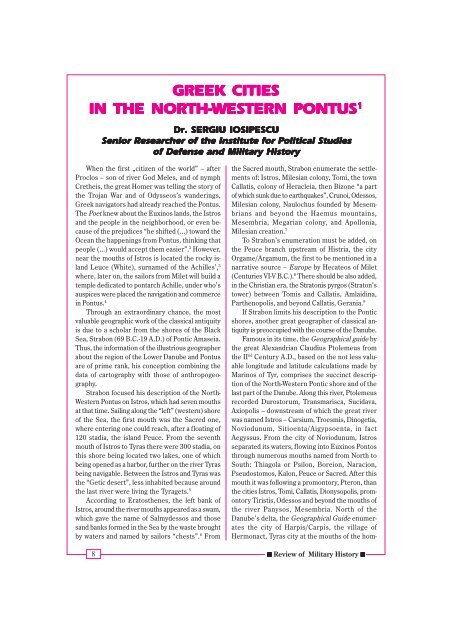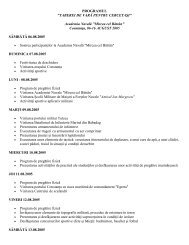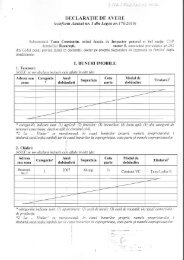Create successful ePaper yourself
Turn your PDF publications into a flip-book with our unique Google optimized e-Paper software.
GREEK GREEK CITIES<br />
CITIES<br />
IN IN THE THE NORTH-WESTERN NORTH-WESTERN PONTUS PONTUS1<br />
Dr. Dr. SERGIU SERGIU IOSIPESCU<br />
IOSIPESCU<br />
Senior Senior Senior Senior Senior Re<strong>sea</strong>rcher Re<strong>sea</strong>rcher Re<strong>sea</strong>rcher Re<strong>sea</strong>rcher Re<strong>sea</strong>rcher of of of of of the the the the the Institute Institute Institute Institute Institute for for for for for Political Political Political Political Political Studies Studies Studies Studies Studies<br />
of of of of of Defense Defense Defense Defense Defense and and and and and Military Military Military Military Military History History History History History<br />
When the first „citizen of the world” – after<br />
Proclos – son of river God Meles, and of nymph<br />
Cretheis, the great Homer was telling the story of<br />
the Trojan War and of Odysseos’s wanderings,<br />
Greek navigators had already reached the Pontus.<br />
The Poet knew about the Euxinos lands, the Istros<br />
and the people in the neighborhood, or even because<br />
of the prejudices “he shifted (…) toward the<br />
Ocean the happenings from Pontus, thinking that<br />
people (…) would accept them easier”. 2 However,<br />
near the mouths of Istros is located the rocky island<br />
Leuce (White), surnamed of the Achilles’, 3<br />
where, later on, the sailors from Milet will build a<br />
temple dedicated to pontarch Achille, under who’s<br />
auspices were placed the navigation and commerce<br />
in Pontus. 4<br />
Through an extraordinary chance, the most<br />
valuable geographic work of the classical antiquity<br />
is due to a scholar from the shores of the Black<br />
Sea, Strabon (69 B.C.-19 A.D.) of Pontic Amaseia.<br />
Thus, the information of the illustrious geographer<br />
about the region of the Lower Danube and Pontus<br />
are of prime rank, his conception combining the<br />
data of cartography with those of anthropogeography.<br />
Strabon focused his description of the North-<br />
Western Pontus on Istros, which had seven mouths<br />
at that time. Sailing along the “left” (western) shore<br />
of the Sea, the first mouth was the Sacred one,<br />
where entering one could reach, after a floating of<br />
120 stadia, the island Peuce. From the seventh<br />
mouth of Istros to Tyras there were 300 stadia, on<br />
this shore being located two lakes, one of which<br />
being opened as a harbor, further on the river Tyras<br />
being navigable. Between the Istros and Tyras was<br />
the “Getic desert”, less inhabited because around<br />
the last river were living the Tyragets. 5<br />
According to Eratosthenes, the left bank of<br />
Istros, around the river mouths appeared as a swam,<br />
which gave the name of Salmydessos and those<br />
sand banks formed in the Sea by the waste brought<br />
by waters and named by sailors “chests”. 6 From<br />
the Sacred mouth, Strabon enumerate the settlements<br />
of: Istros, Milesian colony, Tomi, the town<br />
Callatis, colony of Heracleia, then Bizone “a part<br />
of which sunk due to earthquakes”, Crunoi, Odessos,<br />
Milesian colony, Naulochus founded by Mesembrians<br />
and beyond the Haemus mountains,<br />
Mesembria, Megarian colony, and Apollonia,<br />
Milesian creation. 7<br />
To Strabon’s enumeration must be added, on<br />
the Peuce branch upstream of Histria, the city<br />
Orgame/Argamum, the first to be mentioned in a<br />
narrative source – Europe by Hecateos of Milet<br />
(Centuries VI-V B.C.). 8 There should be also added,<br />
in the Christian era, the Stratonis pyrgos (Straton’s<br />
tower) between Tomis and Callatis, Amlaidina,<br />
Parthenopolis, and beyond Callatis, Gerania. 9<br />
If Strabon limits his description to the Pontic<br />
shores, another great geographer of classical antiquity<br />
is preoccupied with the course of the Danube.<br />
Famous in its time, the Geographical guide by<br />
the great Alexandrian Claudius Ptolemeus from<br />
the II nd Century A.D., based on the not less valuable<br />
longitude and latitude calculations made by<br />
Marinos of Tyr, comprises the succinct description<br />
of the North-Western Pontic shore and of the<br />
last part of the Danube. Along this river, Ptolemeus<br />
recorded Durostorum, Transmarisca, Sucidava,<br />
Axiopolis – downstream of which the great river<br />
was named Istros – Carsium, Troesmis, Dinogetia,<br />
Noviodunum, Sitioenta/Aigypsoenta, in fact<br />
Aegyssus. From the city of Noviodunum, Istros<br />
separated its waters, flowing into Euxinos Pontos<br />
through numerous mouths named from North to<br />
South: Thiagola or Psilon, Boreion, Naracion,<br />
Pseudostomos, Kalon, Peuce or Sacred. After this<br />
mouth it was following a promontory, Pteron, than<br />
the cities Istros, Tomi, Callatis, Dionysopolis, promontory<br />
Tiristis, Odessos and beyond the mouths of<br />
the river Panysos, Mesembria. North of the<br />
Danube’s delta, the Geographical Guide enumerates<br />
the city of Harpis/Carpis, the village of<br />
Hermonact, Tyras city at the mouths of the hom-<br />
8 ����� Review of Military History �����

















